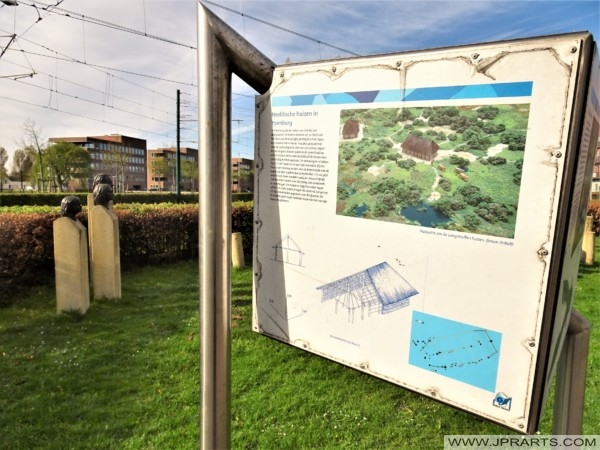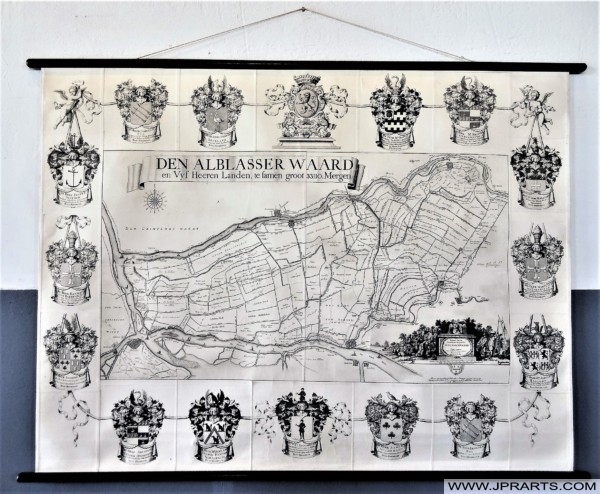The area of the present-day Netherlands has been inhabited by humans for many tens of thousands of years, that is, on the dry coastal strips and the high sandy soils. This period, up to and including the last ice age (± 10,000 BC), is called the ‘old stone age’ (paleolithic). The oldest human traces found in the Netherlands (of Neanderthals in gravel layers near Maastricht) are 250,000 to 350,000 years old. The penultimate ice age then made life in this area impossible. The first modern humans were hunters during and after the last ice age, who chased their prey here and were the first ‘permanent’ inhabitants, so to speak. Flint axes and arrowheads still testify to their presence.
The Netherlands in Prehistory
Los Países Bajos en la Prehistoria
After the Ice Age, in the Middle Stone Age (Mesolithic), the area was inhabited by various tribes, as evidenced by a hunting camp found at Bergumermeer, Friesland (about 8000 BC). In the warmer period after the Ice Age, the Netherlands was a very suitable area for hunters. West of the present-day provinces of Noord-Brabant, Gelderland, Overijssel and Drenthe, the Netherlands was one large swamp delta intersected by countless streams, lakes and peatlands. The IJsselmeer did not yet exist and was a huge peat swamp. It teemed with waterfowl and fish that provided a good food source for hunters and gatherers. The first canoe in history comes from this period (Pesse canoe, ca. 7900 BC).
Die Niederlande in der Vorgeschichte
هولندا في عصور ما قبل التاريخ

Due to the rise in sea level as a result of the melting of the ice caps, the western part of the Netherlands turned into a Wadden area. The deposits consisted of sand and old blue sea clay. Reeds grew on the sea clay, which was the beginning of peat formation. Around 5300 BC. the ‘new stone age’ (neolithic) began with the first farmers who came to the area, as can be seen from grave finds and traces of farms on the loess plateau in South Limburg. They belonged to the Linear Band Ceramics and took, among other things, grain, lentils and peas. This culture could not spread to the rest of the Netherlands because its carriers did not yet know a plow with which to work the clay soils. Around 4500 BC. the Band-ceramic agricultural culture disappeared temporarily. From around 4300 BC. only traces of hunters/farmers (Swifterbant) remain. About 4100 BC. The funnel beaker culture in Drenthe left behind the best-known monuments from regional prehistory: the megalithic megalithic monuments. After 3900 BC. this culture has disappeared.
史前时期的荷兰
Les Pays-Bas dans la Préhistoire
From about 3000 BC. a coastal barrier was created in the form of beach walls and low dunes. Behind the beach walls, the land changed from a tidal landscape into a lagoon and then into a peat swamp. Remains of the Vlaardingen culture, named after the first Vlaardingen site, have been found in the west of the Netherlands. This culture covers the period from 3500 BC. to 2500 BC. The first wheel found in the Netherlands dates from about 2400 BC, although this is already known from elsewhere in the Funnel Beaker culture. The people of the Bell Beaker culture, who built settlements along the Atlantic coast from Morocco to Scandinavia, were already using copper. This copper age is seen as the last phase of the new stone age. For the first time metalworking took place in the Netherlands, as demonstrated by stone anvils and copper tongue daggers, which were found on the Veluwe near Lunteren.
Нидерланды в предыстории
Nederland in de Prehistorie
Metalworking expanded by 2000 BC, marking the start of the Bronze Age. This especially brought a lot of prosperity to Drenthe, through which an important trade route probably ran towards the Baltic Sea and Scandinavia. Around the first millennium BC, the Netherlands came into the area of influence of the Central European urnfield culture.
In the Iron Age, the southern Netherlands came under the influence of the proto-Celtic Hallstatt culture. However, actual Celtic immigration has not been demonstrated. A first Germanic influence from the northeast is visible with the Harpstedt-Nienburg culture, which fell under the pre-Roman Iron Age. In the first centuries before the era, Germanic tribes entered the Netherlands from the east and for the time being settled in the northern regions and around the major rivers. Groups, who inhabited the clay area of Friesland and Groningen, began to build their houses on mounds to withstand the incoming sea. Later they developed dikes and pumps to protect the land as well.
Tarih Öncesi Hollanda
Holandia w Prehistorii
Visit Netherlands Travel to Book Flights and Hotels Easy Online
Visit the Cheap Webshop for Blu-rays, Books and DVDs





